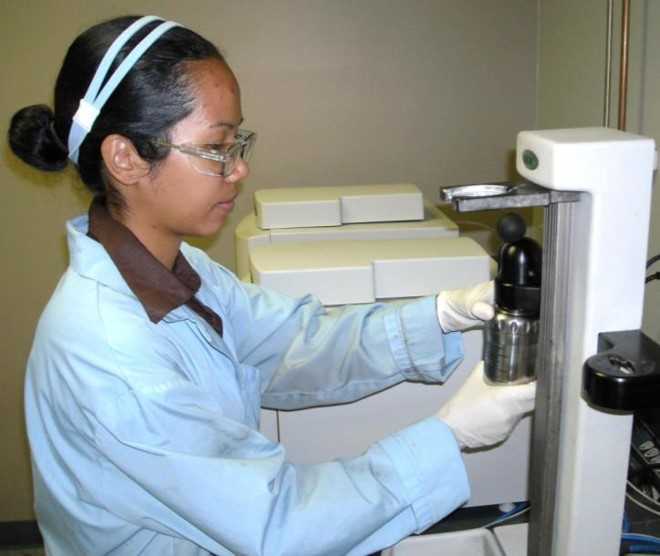Measuring energy of coal
The heat energy that a coal releases is typically referred to as the coal’s ‘calorific value’ It may also occasionally be referred to as the coal's "specific energy" The instrument used to determine the coal's calorific value is termed the calorimeter. International (ISO 1928) and national (ASTM D5865) standards describe the process in detail. Essentially, a weighed 1 gram sample of coal that has come into equilibrium with the laboratory's atmospheric conditions is placed in a steel pressure vessel. This vessel is then pressurized with oxygen. The pressure vessel is immersed in a water-filled bath at a set temperature. Once the temperature has stabilized, the coal inside the pressure vessel is ignited with an electrical charge. The released energy heats the bath and the change in the bath's temperature is precisely measured. Allowances are made for heat release by the ignition fuse materials, thermochemical corrections and for heat transfer between the calorimeter and its surroundings. The analysis produces a Gross Calorific Value.
As calorific value is effected by various components in the coal, a range of additional test will also be conducted on the coal. These will include two types of moisture determinations; 1) an as-sampled total moisture to determine the energy value of the coal as-sampled, and 2) a Moisture in the Analysis Sample test to determine the concentration of water in the pressure vessel. The laboratory will also determine the concentration of sulfur, hydrogen, oxygen and nitrogen (if a Net Calorific Value is required).
There are three ways in which the gravimetric energy density of a coal is presented: MJ/kg, kcal/kg and Btu/lb. There are simple conversion factors between the various units:
- from kcal/kg to MJ/kg multiply by 0.004187
- from kcal/kg to Btu/lb multiply by 1.800
- from MJ/kg to kcal/kg multiply by 238.846
- from MJ/kg to Btu/lb multiply by 429.923
- from Btu/lb to kcal/kg multiply by 0.5556
- from Btu/lb to MJ/kg multiply by 0.002326
Calculating energy of coal
Various equations are required to convert the Gross Calorific Value obtained in the calorimeter to a value that is useful for power-station operators or coal contract settlements.
Sulfur Correction
The calorific value must be corrected for sulfur to account for the energy released on the formation of sulfuric acid in the calorimeter.
Equation 1: Correction for Sulfur
CVcorrected = CVuncorrected - (0.0952 x S(%))
Where:
- CV = Gross Calorific Value (MJ/kg) (as analyzed basis
- S = Total Sulfur (%) (as analyzed basis)
Net calorific value correction
The calorimeter produces a Gross Calorific Value. Coal contracts typically require a Net Calorific Value result as this better represents the practical energy of the coal. There are two ways of calculating Net Calorific Value for ISO; at constant volume and at constant pressure. In normal pulverized fuel power-stations operations, net constant pressure best approximates the energy produced by the coal but either equation may be required in a commercial contract.
The equations that are used to convert from Gross to Net Calorific Value calculation achieves the following:
- They convert the result from a moisture in the analysis sample basis to a moisture in the as-sampled or as-received basis.
- They correct for the latent heat of vaporization of water. At the completion of the calorimeter test, the water vapor produced during the test has precipitated out and the energy gain from this adds to the total energy released. In a pulverized fuel power-station, the combustion products do not get sufficiently cool to precipitate out prior to the flue gas exiting the boiler and therefore this energy is lost.
Equation 2: Net Calorific Constant Volume Calculation ISO Method
CV(NAR) = (CV(d) - (206.H(d))) x (1 - (0.01 x TM(ar))) - (23.05 x TM(ar))
Equation 3: Net Calorific Value Constant Pressure Calculation ISO Method
CV(NAR) = (CV(d) - (212.H(d)) - 0.8x(O(d)-N(d))). (1-(0.01 x TM(ar))) - (24.43 x TM(ar))
Where:
- CV(NAR) = Net Calorific Value (J/g) (as received basis)
- CV(d) = Gross Calorific Value (J/g) (dry basis)
- H(d) = Hydrogen % (dry basis)
- O(d) = Oxygen % (dry basis)
- N(d) = Nitrogen % (dry basis)
- TM(ar) = Total Moisture (as received basis)
Note in the preceding two equations that the calorific value produced by calorimeter test needs to be presented in joules/gram (J/g). To convert from MJ/kg to J/g multiply by 1,000. To convert from J/g to MJ/kg divide by 1,000.
Equation 4: Conversion of Hydrogen (as analyzed basis) to Hydrogen (dry basis)
The equations that convert from Gross Calorific Value to Net Calorific Value require hydrogen to be on a dry basis. This is not a standard basis conversion equation as the hydrogen associated with moisture needs to be removed from the air dried (as analyzed) result.
H(d) = (H(ad) - M(ad) / 8.937). (100 / (100 M(ad))
Where:
- H(d) = Hydrogen (dry basis)
- H(ad) = Hydrogen (as analyzed basis)
- M(ad) = Moisture (as analyzed basis)
 Rechercher
Rechercher
 français
français
 Connexion
Connexion






















































